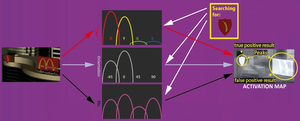Information
- Publication Type: Master Thesis
- Workgroup(s)/Project(s):
- Date: May 2011
- TU Wien Library:
- First Supervisor:
Abstract
Computer games have become one of the most important parts of entertainment industry. Due to a tremendous reach, particularly among important customer groups such as adolescents and young adults, this media is recently considered as an appealing channel for advertising. However, little is known about the effectiveness of advertising in computer games. Its interactive nature comes with a fundamental difference in the perception of advertisements compared to traditional media such as television. The intense user interaction in computer games interferes with players’ memory and attention, as players primarily focus on the current performed task. Information such as advertisements billboards which is not directly related to the gaming task remains unnoticed. This behavior, known as inattentional blindness, is a main problem for the optimal placement of information (e.g. game-relevant messages) or advertisements in the game’s virtual environment. This thesis will review the history, current methods and issues of advertising in computer games. It will particularly discuss the perception of embedded advertisement billboards and propose one way to break through inattentional blindness, in order to make advertisements which are embedded in an action game’s environment more visible. The underlying approach is based on Wolfe’s theory of Guided Search, which provides a fairly reliable model for top-down controlled visual attention during visual search tasks. Since computer games frequently involve visual search tasks, we hypothesize that this model can be applied in a “reverse” direction to increase the saliency of some advertisements on a cognitive level, to get noticed even in the presence of a strong task.To validate this hypothesis, a computer game was implemented to conduct a user study for testing the memory effectiveness.Additional Files and Images
Weblinks
No further information available.BibTeX
@mastersthesis{ZL_2011_IVIG,
title = "Improving the Visibility of In-Game Advertisements",
author = "Le Zhang",
year = "2011",
abstract = "Computer games have become one of the most important parts
of entertainment industry. Due to a tremendous reach,
particularly among important customer groups such as
adolescents and young adults, this media is recently
considered as an appealing channel for advertising. However,
little is known about the effectiveness of advertising in
computer games. Its interactive nature comes with a
fundamental difference in the perception of advertisements
compared to traditional media such as television. The
intense user interaction in computer games interferes with
players’ memory and attention, as players primarily focus
on the current performed task. Information such as
advertisements billboards which is not directly related to
the gaming task remains unnoticed. This behavior, known as
inattentional blindness, is a main problem for the optimal
placement of information (e.g. game-relevant messages) or
advertisements in the game’s virtual environment. This
thesis will review the history, current methods and issues
of advertising in computer games. It will particularly
discuss the perception of embedded advertisement billboards
and propose one way to break through inattentional
blindness, in order to make advertisements which are
embedded in an action game’s environment more visible. The
underlying approach is based on Wolfe’s theory of Guided
Search, which provides a fairly reliable model for top-down
controlled visual attention during visual search tasks.
Since computer games frequently involve visual search tasks,
we hypothesize that this model can be applied in a
“reverse” direction to increase the saliency of some
advertisements on a cognitive level, to get noticed even in
the presence of a strong task.To validate this hypothesis, a
computer game was implemented to conduct a user study for
testing the memory effectiveness.",
month = may,
address = "Favoritenstrasse 9-11/E193-02, A-1040 Vienna, Austria",
school = "Institute of Computer Graphics and Algorithms, Vienna
University of Technology ",
URL = "https://www.cg.tuwien.ac.at/research/publications/2011/ZL_2011_IVIG/",
}

 poster
poster thesis
thesis


